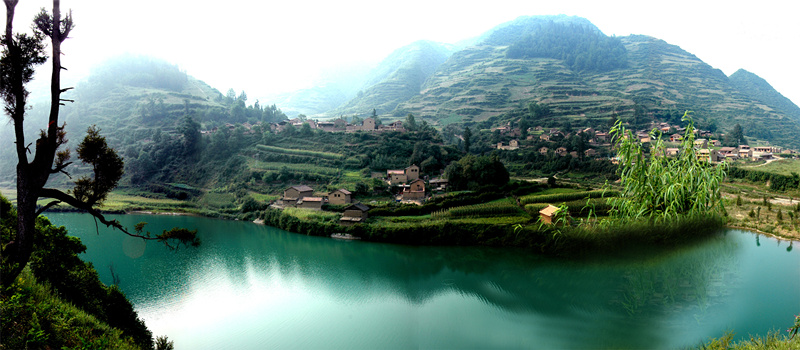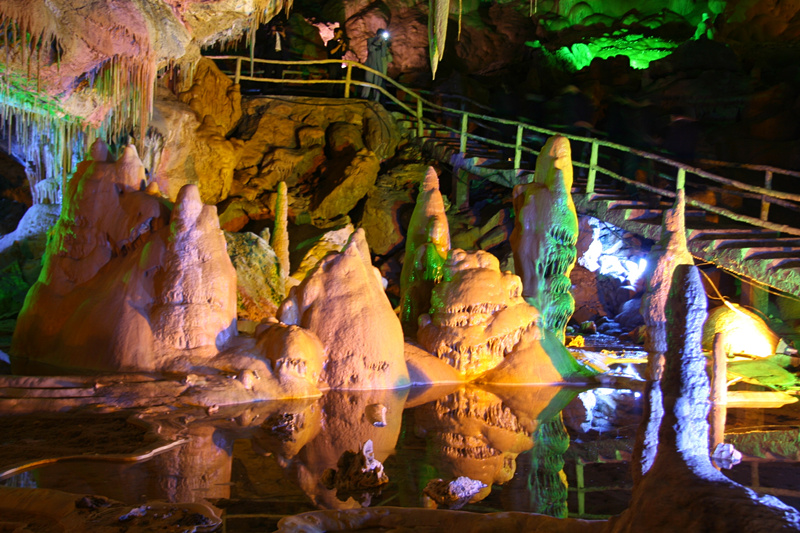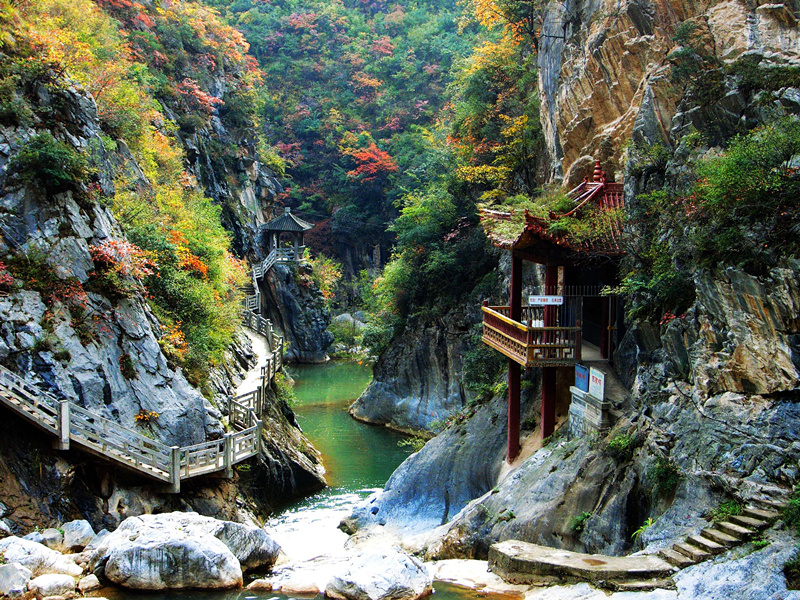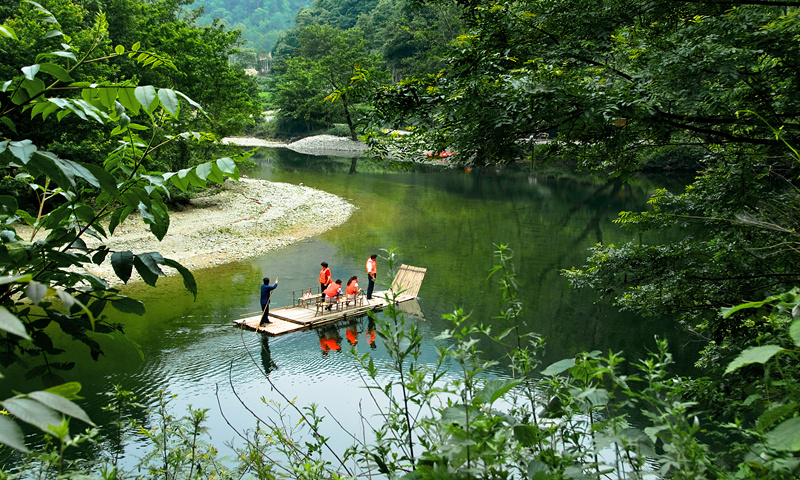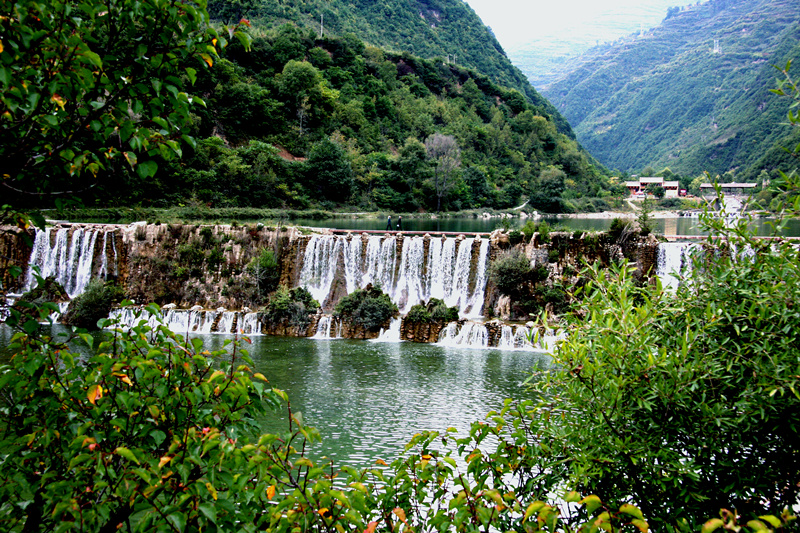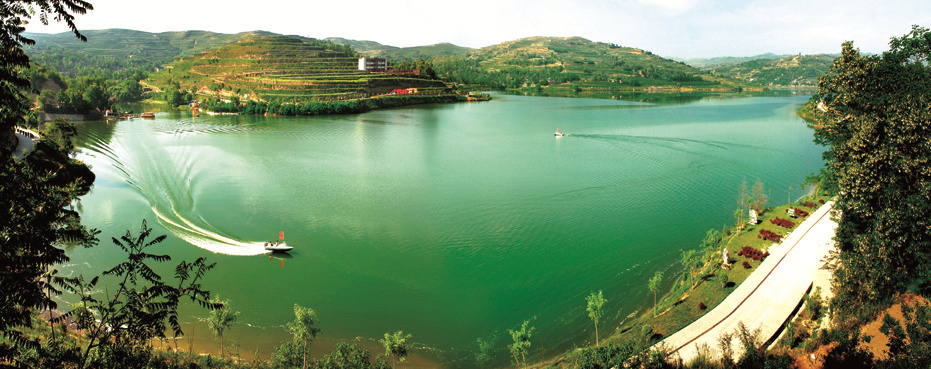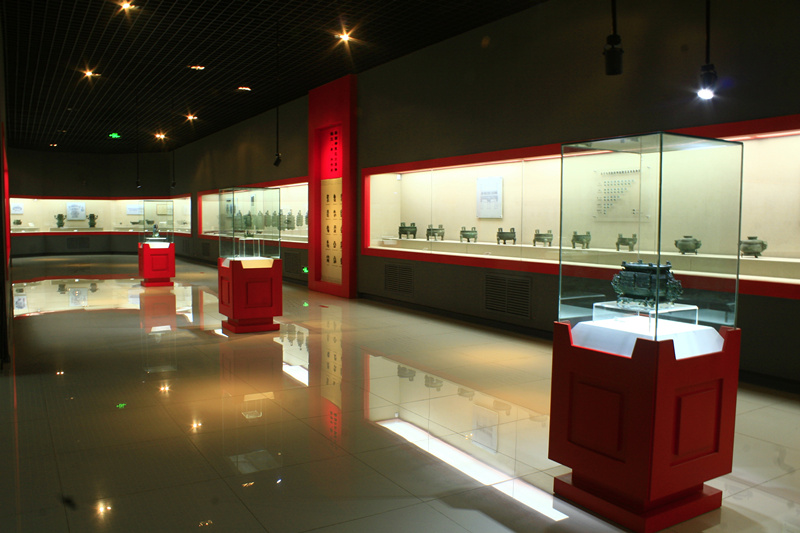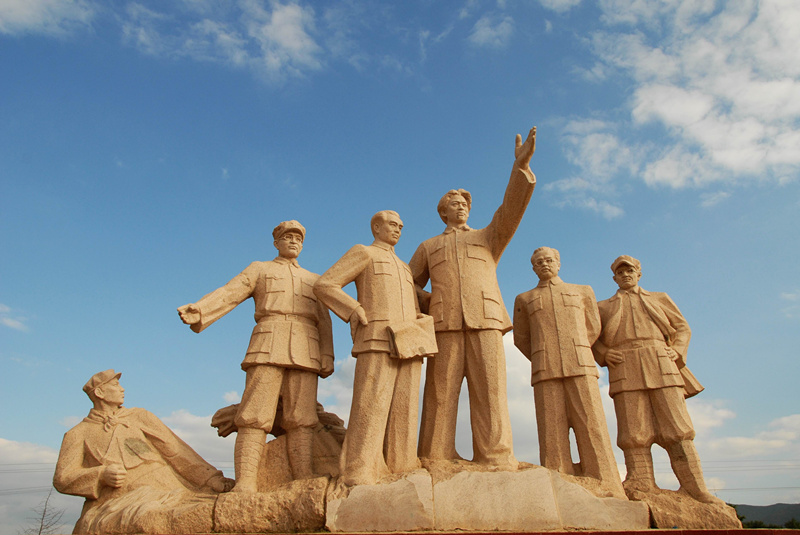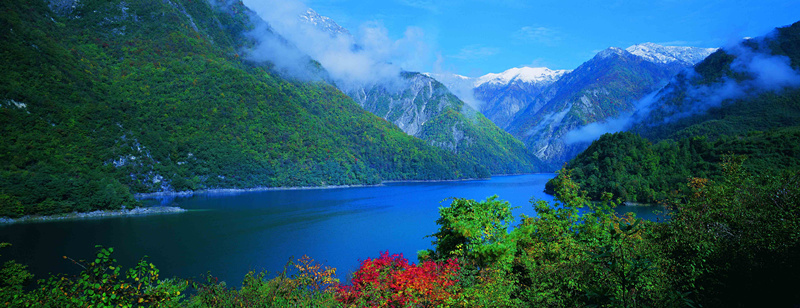Longnan City
Longnan is located in the south of Gansu Province, and also in the Qinba (Qinling Daba) Mountain Ranges. As the hub of Gansu, Shaanxi, and Sichuan, Longnan has been called “the traffic lock-and-key of Gansu and Shaanxi, and the crucial passage to Sichuan". Longnan city also is praised as having equally beautiful landscapes like East China’s Zhejiang Province. The total area is 27,900 square km, and its population is 2.828 million. Under its jurisdiction are Wudu District and eight counties – Tanchang, Wenxian, Kanxian, Chengxian, Huixian, Lixian, Xihe and Liangdang. Longnan is located in the transitional area between the subtropical zone and warm temperate zone. Longnan borders Shaanxi Province and Sichuan Province, and it is the only part in Gansu that belongs to Yangtze River Basin. The city enjoys a mild climate and is rich in rainfall. Longnan is distributed densely with rivers and brooks, and it has high forest coverage rate. No wonder this place is always compared to East China’s scenic spots. The annual mean temperature here is 9—15 degrees Celsius, the annual rainfall is 400—1,000 millimeters. Its annual frost-free period lasts 160—280 days with an altitude of 550—4,200 meters. Longnan has obvious ecological differences, so people say “There are four seasons in a mountain and a five-kilometer distance can cause changes in weather condition." Longnan is one of the birthplaces of Chinese nation and a multi-ethnic inhabitance. So far, the Ningjiazhuang site in Longnan has over 7000 years history. The first ancestor of humanity in legend, Fuxi, was born in Chouchi Mountain of Longnan. The progenitor of Qin people lived around today’s Lixian and Xihe Counties. The old Di and Qiang ethnic minorities established local authorities here. Han, Tibetans, Hui, ancient Di, Qiang and some other ethnic groups all have long lived in communities here, and they formed colorful customs. The regional cultures of Qinlong and Bashu, as well as the ethnic cultures of Han, Tibetans and Hui have long been in exchanges and mutually influenced, making the local culture of Longnan typical yet in harmonious coexistence. Longnan has moderate climate and beautiful scenery. Yinping Tianchi (Heavenly Lake) is one of the three great Tianchi lakes in China; Wudu Wanxiang Cave, which is the biggest karst cave in the northwest of China; Baishuijiang Nature Reserve, which is the national key nature reserve and the only land in Gansu with a northern subtropical eco-system and a beautiful natural landscape. it is praised as “Xishuangbanna of Gansu Province". Daheba (Big river dike), Santan, Hongtu River, Meiyuan Valley, Yunping Mountain and other natural spots are distributed all across Longnan, so people called it as “Little Jiuzhaigou Valley in Gansu". Longnan not only has beautiful landscape and splendid culture, but also has a long history. Shih Chi (The Historical Records) recorded that Fuxi, “was born in Chouchi and grew up in Chengji". Chouchi is today’s Xihe County of Longnan now. So far, the Fuxi Cliff still towers aloft on Chouchi Mountain. Longnan is the birthplace of the Qin Dynasty, which is the first feudal empire in Chinese history. The First Emperor of Qin established his empire in Guanzhong (the Central Shaanxi Plain), after conquering six states. Located in Chengxian County, Longnan City, the inscriptions on precipices, Ode to Xixia is the most complete treasure of calligraphic art in “Three Eulogies" of the Han Dynasty. Hadapu Township of Tanchang County, was the the Chinese Workers’ and Peasants’ Red Army’s “service station" for brief rest in the Long March and the turning point of deciding the fate of Chinese revolution. The Memorial Hall of the Red Army’s Long March here has been listed as the Major Historical and Cultural Site Protected at the National Level. Here, the characteristic artificial landscape and natural scenery enjoy some striking similarities with Jiu Zhaigou Valley in Sichuan Province and Maiji Mountain in Tianshui city, Gansu Province. The culture here, as a result of the unique geographic position, is of great diversity. There are both the fusion of ethnic cultures of ancient Di, Qiang, Tibetan ethnic groups and the culture of Han people. and the exchanges of the culture of Qinlong and Bashu. The unique folk customs provides a picture for visitors to closely appreciate. Wanxiang Cave in Wudu District (AAAA)
Wanxiang Cave is located in the mountainside of Lugushan Mountain of Yangpang Village, Hanwang County, on the south bank of Bailongjiang River, Wudu District, Longnan City. It is 12 kilometers from Wudu. This cave is 250 million years old, and its grand scale and high artistic value can compare favorably with the world famous Reed Flute Cave in Guilin and Seven Star Cave in Zhaoqing. This cave not only has the magnificent northern style, but also has the delicate southern beauty. It is one of the four famous caves in China. Wanxiang Cave enjoys a high reputation of “The No.1 cave in China", meanwhile it is also called “underground cultural corridor" and “underground art palace". Wangxiang Cave is also called Xianren Cave (Fairy Cave) and Wuxian Cave (Five Fairies Cave), because that, according to legend, there were five fairies disciplined here. It has the typical karst landform. In this cave, the depth is unfathomable and the landforms are complex and winding. The smallest place is less than one meter tall, which just can allow one people to crawl. However, the biggest place is spacious, which has hundreds of meters in length and breadth. There are around 360 thousand square meters of stalactite, stalagmite, stalagnate and stone flower, which are spread all over the place. At present, there are three scenic spots that have been developed -- Moon Palace, Dragon Palace and Heavenly Palace. Wanxiang Cave is 190 meters higher than Bailongjiang River at an altitude of 1150 meters. Yet in the humid cave, there are many streams, rhythmically flowing by. Both ends are connected with the outside, so the cave has sufficient oxygen with a stable temperature at 14℃ throughout the year. It is a popular summer resort. Ode to Xixia Scenic Area (AAAA)
Ode to Xixia Scenic Area lies in the foothills of Tianjing Mountain in Yuqiaoxia Gorge, 13 km on the west of Chenxian County. The scenic spot has the breathtaking beauty of nature and towering cliffs. The running spring water in the gorge sends spray in every direction and the flow of water is ever-changing due to the jagged stones, all of which make it a scenic resort. Everywhere is waterfall, turbulent flow, ponds and small lakes. Ode to Xixia, also known as Huianxibiao, a calligraphy work, was carved in 171 A.D. of the Eastern Han Dynasty. It is the best-preserved inscription work on precipices of Eastern Han dynasty in China, commonly known as Huanglong Monumental Inscription and Calligraphy, which has high valuefor archaeological research and calligraphic appreciation. Xixia Gorge boasts of unique hills and water beautiful. The views in front of your eyes are the skyscraping Mountains sprung from the ground on one side and cliffs with varying heights on the other side. The cliff is covered with a thick growth of trees, and sky-kissing ancient trees which are twined by vines. The river between the cliffs and the mountain trickles through the valley and in certain places rushes down over the rocks. The most interesting scene is the water hanging down from the cliff like bead curtains dropping from above, making a tremendous spectacle. Yangba Natural Scenic Spot in Kang County(AAAA)
Yangba ecological scenic spot lies in the southeast of Kangxian County, covering an area of 504.93 Square kilometers. The climate there is warm and humid with beautiful scenery. There are almost 40 kinds of rare trees such as yew, Camphor tree and white bark pine; there are 36 kinds of rare animals such as snub-nosed monkeys, golden cats and giant salamanders. It also has more than 200 kinds of natural scenic spots where the forest coverage is over 70%, which is among the highest in Gansu province. Yangba depends on the unique advantages of ecological resources, beautiful cultural sights and an abundant supply of healthy wild products to make it as beautiful as south of the Yangtze River. The most representative scenic spots are Primeval Forest which covers two thirds area of south Kangxian county, Sights of Tea Garden and fantastic Meiyuan Ditch, which are regarded as Gansu’s Xishuangbanna and the hometown of famous tea in the world. The ecological scenic spot in Yangba subtropics, with an altitude of only 500 meters, is next to Hanzhong in the east, near Guangyuan in the south, neighboring an immense forest in the west and the Yanzihe River flies by the north. The bamboo forest stands, reaching for the sky. The green tea garden hiding between the light green banana, blackish green gardenias and the silver green loquat, is a fertile and beautiful basin valley in the south of Kangxian County. The annual average temperature is 11℃ so summer is the best season to travel here. Guan’egou Valley Scenic Area (AAAA)
Guanegou Valley Scenic Area is located in the outskirts of Tanchang County, 340 kilometers from the provincial capital city Lanzhou, Gansu province. It take up the converging area of the east of Qinghai-Tibet Plateau and the branches of two mountain ranges, Mount Qinling and Mingshan. The scenic area adjoins the famous historical and cultural township Hadapu. The overall length of Guanegou Valley is 32 kilometers, covering an area of 17,637 hectares with the forest coverage rate 75.1%. There are thirty colorful lakes in the front part of the valley covering a length of 14km and primeval forest with thick pines and cypresses in the back part covering a length of 18km. There are nine steep canyons. If you look up in them, the cliffs soar up above the clouds. Eleven waterfalls drop from the peaks or halfway of the cliffs. Meanwhile, there are more than sixty amazing scenic spots. The deepest place is the alpine meadows and perennial snow-capped mountains. The whole park includes six main scenic spots: Daheba Gorge, Maquan Gorge, Gang Gorge, Baxia Gorge and Damiao Beach. The park combines natural views with a rich culture into an organic whole, such as forest, prairie, waters, geomorphologic and astronomical landscape. The landscape is outstanding. The rich flora and fauna variety creates an elegant ecological environment. The Sunset Glow Lake of Xihe County (AAAA)
The Sunset Glow (Wanxia) Lake is located in Jiangxi Township which is 5 km west of Hexi County, Longnan City. It is one of the top ten tourist attractions in Longnan and a famous high mountain reservoir in Gansu Province. It belongs to the Yangtze River Basin and Jialing River system. The lake is accessible from different directions. This reservoir, surrounded by green mountains, is full of fish and shrimp. Laohukou Waterfall always presents a splendid sight. The natural resources and cultural landscapes create a great environment for sight-seeing. Moreover, the local people organize traditional activities on the night of 7th July in the lunar calendar every year at The Sunset Glow Reservoir, for Xihe County is the birthplace of Qiqiao Culture. As a large-scale integrated water scenic spot, it is equipped with farmhouse accommodations for tourists with Xihe architectural style. The tree-lined lake is scented by flowers. Visitors always enjoy the sight of shimmering waters and flying birds. This scenic spot is inhabited by more than 30 kinds of migrating birds. It has already become an attractive water park both for leisure and entertainment. Gansu Museum of Qin Culture (AAAA)
Gansu Museum of Qin Culture is located by Qin People Square in the development zone of Chengguan Township, Lixian County, Longnan City, Gansu Province. It takes up an area of 43,864.7 square meters, in which the building area is 20,553 square meters, and the main building covers 8,350 square meters. The building, facing the east, represents a primitive simple style of Pre-Qin architecture, and contains an Exhibition Hall, a Meeting Room, a Lecture Theater and warehouse, etc. Gansu Museum of Qin Culture possesses a collection of more than 5000 precious relics; among them 150 are “Level I National Historical Cultural Relics". It has a rich collection of over 10000 volumes of ancient books. Qin Museum Display well serves the functions of displaying antiques, academic research and cultural tourism. The second floor mainly demonstrates Pre-Qin cultural relics. The third floor shows the history and customs of Lixina County as well as some valuable paintings and calligraphy left behind by old academies. Hadapu Memorial Hall for the Long March of Red Army
The Hadapu Memorial Hall for the Long March of the Red Army is situated in Hadapu Township, Tanchang County, at the foot of Minshan Mountain. Hadapu, the honorable site commemorating the Chinese Revolution, has already become the household name of Red-tourism in Tanchang. The State Council, when publishing the list of Major Historical and Cultural Sites Protected at the National Level, announced that Hadapu was the most crucial place for the survival of the Red Army in the Long March. The former site of the Long March of the Red Army in Hadapu is located on a 1200-meter street, which consists of 382 stores. The street is called “The First Street of the Chinese Workers’ and Peasants’ Red Army" as it is the best-preserved street that the Red Army passed. Hadapu was announced to be a Major Historical and Cultural Site Protected at the National Level in October 1981. The Hadapu Memorial Hall was built in 1987. In September 1994 it was named by the Gansu Provincial Party Committee as the Provincial Exhibition Center of Patriotism Education. In May 2000, it was named by the Gansu Committee for National Defense Education as the Base for Defense Education in Gansu Province. It was named as the National Exhibition Center of Patriotism Education by Publicity Department of the CPC in June 2001. In June 2001, this site was declared by the State Council to be a Major Historical and Cultural Site Protected at the National Level and was listed in Top 100 Classic Scenic Spots for Red-Tourism in 2005. Wenxian Tianchi (Heavenly Lake)
Wenxian Tianchi National Forest Park is located in the mountains 100 km north of Wenxian County, Longnan city. As a result of tectonic shifts in ancient times, the crustal faults blocked the local Yangtang River and formed a lake with the shape of gourd on Tianwei Mountain. Its altitude is more than 2400 meters. There are 9 bays and 108 coves in Heavenly Lake, covering a total area of 20 square km with a water area of 80 hectares. The depth of the water is 97 meters. Wenxian Tianchi was called Tianwei Pond in ancient times; it is named after the mountain. As a picturesque landscape, Tianchi (Heavenly Lake), is one of 8 notable sights in Wenxian County. The expanse of the mist-covered lake joins the sky. With the changes of the four seasons, the scenery gets different while the beauty never fades. Sometimes the quiet lake is just like a mirror; sometimes the glittering water shines like brilliant golden and silver lights. Mountain cliffs, flourishing woods and tall bamboo trees are reflected in the water. Tianchi has numerous different tourist attractions. In the mountains beside Heavenly Lake, there is a thick forest plantation, including some valuable kinds of trees -- Chinese pines, birch trees, Betula, Pinus massoniana, purple spruce and fir, etc. The forest is also a natural zoo and is a habitat of wild animals including antelopes, argali sheep, leopards, hydropotes, deers, wild boar, and bears, as well as golden pheasant, eared pheasant, thrush and other birds. The forest park is also a treasure house; here are so many precious medicinal materials such as Codonopsis Pilosula, Angelica sinensis, Chinese caterpillar fungus, fritillary and the root bark of the peony tree, etc. There are also local spetialties with wild flavors such as agarics, walnuts, ferns, apples and wild strawberries, etc. The forests beside the Tianchi The pond changes colors with seasons and so does the lake’s water. The Thatched Cottage of Du Fu in Chengxian County
Du Fu’s Thatched Cottage, also called Dugong Hall, is located at the gateway of Feilong Gorge, 3.5km southeast of Chengxian County, Longnan city. It is a memorial building, commemorating a famous poet of the Tang Dynasty, Du Fu, who spent his drifting days like a refugee here in Tonggu. It is also the one with the longest history among current 37 Thatched Cottages of Du Fu. In the October of 759 AD, the 2nd year of the Qianyuan period under the reign of Emperor Li Heng, Du Fu departed Tianshui to Feilong gorge. The humble thatched cottage was built on the west side of the gorge, on the shaded side slope of the mountain. Therefore this thatched cottage provided the proof for the sage of poet Du Fu’s refuge here in Longnan. And from here, he moved on to the south, heading for Sichuan Province. Du Fu produced many excellent poems in the cottage. The Memorial Hall was built on the original site of the thatched cottage to commemorate this outstanding personage in Chinese literature. From then on, it was renovated and enlarged repeatedly during the Song Dynasty, the Ming Dynasty, the Qing Dynasty and during the Republic of China. Then it begun to take the shape of a solemn and serene landscape. Within the thatched cottage, there are more than 10 steles and poem stone tablets including the poem tablet inscribed by Yuwen Zizhen in the 4th year of the Shaoxi period under the reign of Emperor Zhao Dun in the Song Dynasty. Two poem tablets were set up separately in the 9th and 19th year of Jiajing period under the reign of Emperor Zhu Houcong. The stone tablet was set up in the 47th year of Wanli period under the reign of Emperor Zhu Yijun, of the Ming Dynasty. After the reconstruction and expanding by Chengxian County government in recent years, the thatched cottage provides the ideal landscape with solemnity and simplicity for people to commemorate the sage of Chinese Poems, Du Fu. |
Longnan City
December 21, 2016
VIEWED: 0
Recommended Products
see all-
Paris to Marrakech
HKD 6415 + Book -
Spain, Portugal & Morocco
HKD 3645 + Book
